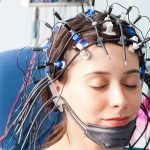What is a calcium scan or EBT?
The calcium scan, also called electron beam computed tomography (EBT), is a noninvasive diagnostic test used for taking clear pictures of the heart. Calcium scans may be useful for detecting early signs of heart disease before heart problems would show up on other noninvasive tests; however, it is less accurate than these other tests. Calcium scans involve rapidly scanning the heart with an X-ray machine. The test measures levels of calcium in the arteries of the heart. As fatty plaque builds up in the arteries of the heart, calcium accumulates in the plaque and contributes to the hardening of the arteries. The amount of calcium in your arteries may predict whether or not you are at high risk for future heart problems, such as a heart attack. (The calcium in your arteries is not related to the calcium in your diet.) Currently, EBT (or Ultrafast CT) does not provide information about how the heart is working, but the machines are evolving rapidly and may do so in the future.
Who might have a calcium scan?
Guidelines written in 2000 do not recommend calcium scans for healthy people or those with symptoms of heart disease.1 This is because calcium scans are relatively new and it is not clear what the test results mean in terms of your risk for a heart attack or other heart problems. Since then, there have been studies suggesting that calcium scans may be useful for detecting early signs of fatty plaque buildup in women with risk factors who have no symptoms of heart disease. In addition, calcium scans are not always covered by insurance. Despite this, an estimated 300,000 calcium scans are performed annually in the US.2
Who should not have a calcium scan?
If you are pregnant, you should not have any kind of X-ray procedure, including a calcium scan. If you are not able to hold your breath (this can be a problem for women with heart failure), you should not have a calcium scan. EBT is also not recommended if you have had bypass surgery or undergone stent placement—the metal in the stent or surgical clips can affect the image quality.
The Calcium Scan Procedure
How do I prepare for a calcium scan?
There is no special preparation or fasting required although you may be asked to avoid caffeine and smoking for a few hours before the test.
What does it entail?
You will undress from the waist up, put on a hospital gown, and lie on the scanner bed. Electrodes will be attached to your chest using sticky patches, and an ECG monitor will be used to monitor the heartbeat so that the nurse or technician can time the X-rays to when the heart is moving the least. This reduces the chance of getting blurred images. The bed then moves into the scanner—a doughnut-shaped machine that is open in the middle. You will be asked to hold your breath for about 20 seconds a few times to help prevent blurring. You will be fully awake for the procedure. The test is relatively quick, and the machine is more open than an MRI; however, some people may still experience claustrophobia. The test takes about 15 minutes.
Test Results
What does a negative calcium scan indicate?
The results of a calcium scan are given as a coronary artery calcium (CAC) score measured in Hounsfield Units (HU). The total calcium score is based on the sum of scores for each fatty plaque 1.0 millimeter squared (mm2) or larger. Calcium scans are very sensitive; if you have fatty plaque buildup in your arteries, the scan will almost always find it. If you have a zero calcium score, it is highly unlikely that you have much fatty plaque in your arteries,3, 4 and you have a low risk of having a heart attack or dying from heart disease in the next 2 to 5 years.1
What does a positive calcium scan indicate?
There is no established definition for a positive EBT or a high calcium score. Some researchers consider any score above zero to be positive; scores of 1 to 99 are considered mild; 100 to 399 moderate; and above 400 is high. Very high scores (400 and above) are associated with a higher risk of having a heart attack or dying from heart disease in the next couple of years,5 but it is not clear what the risks are for lower scores. Because calcium scores increase with age (scores may double every two and a half years),6 another method is to compare your score with typical findings for women your age. If your score is above the average for women your age, you have a higher risk of developing heart problems.
How accurate is calcium scanning in women?
Calcium scans seems to detect calcium equally well in men and women.4 Because EBT is very sensitive, it has a higher risk of false positives than other types of noninvasive diagnostic tests in both men and women.7, 8 A false positive is when the test suggests that you have fatty plaque buildup in your arteries, but in reality you don’t.
Does the same calcium score put women at a greater risk than men?
Some studies suggest that the same calcium score may confer a higher risk for a women than a man. A large study of more than 10,000 healthy men and women (40% were women) found that at every level of calcium score, women had a higher risk of dying at 5 years than men.9 The risk of dying was highest for women with an intermediate to high risk of heart disease (Calculate Your Risk) and a calcium score greater than 400. The reason for this may be because women’s arteries are smaller than men’s, so the same amount of calcium will block off more of the artery.
How is a high calcium score treated?
There is no treatment specifically for high calcium levels. Some studies have shown that taking a cholesterol-lowering drug or adopting a heart-healthy lifestyle may keep calcium scores in check.6, 10, 11 You are unlikely to be prescribed statins based on a high calcium score alone. If your score is high, your doctor may decide that you need more aggressive treatment for other heart disease risk factors, such as your cholesterol levels or blood pressure.
Are there any risks associated with calcium scans?
As with all X-ray procedures, calcium scans involve some exposure to radiation. The amount of radiation you are exposed to during cardiac diagnostic tests is considered safe and the technicians are trained to minimize your radiation exposure. A typical calcium scan uses lower levels of radiation than nuclear stress tests. However, some of the new machines that take very rapid pictures—you hold your breath for only about 5 seconds compared with 20 seconds for the older machines—use much higher amounts of radiation. For information on radiation safety see National Institutes of Health Radiation Fact Sheet.
Does the calcium scan have any limitations?
There is some controversy about the usefulness of calcium scores. Very high scores are strongly linked to an increased risk of heart disease or having a heart attack; however, it is not yet clear what lower scores mean in terms of your risk for a heart attack. Calcium scans are less accurate than other noninvasive diagnostic tests. One of the concerns with calcium scans is that the higher risk of false positive tests may lead to unnecessary further testing. In addition, some fatty plaques that rupture and cause heart attacks do not contain much calcium12 and may not be detected by EBT—while rare, it is possible to have a heart attack and have a zero calcium score.13
References
1. O’Rourke RA, Brundage BH, Froelicher VF, et al. American College of Cardiology/American Heart Association Expert Consensus Document on electron-beam computed tomography for the diagnosis and prognosis of coronary artery disease. J Am Coll Cardiol. Jul 2000;36(1):326-340.
2. Taylor AJ, Al-Saadi N, Abdel-Aty H, Schulz-Menger J, Messroghli DR, Friedrich MG. Detection of acutely impaired microvascular reperfusion after infarct angioplasty with magnetic resonance imaging. Circulation. May 4 2004;109(17):2080-2085.
3. Haberl R, Becker A, Leber A, et al. Correlation of coronary calcification and angiographically documented stenoses in patients with suspected coronary artery disease: results of 1,764 patients. J Am Coll Cardiol. Feb 2001;37(2):451-457.
4. Budoff MJ, Shokooh S, Shavelle RM, Kim HT, French WJ. Electron beam tomography and angiography: sex differences. Am Heart J. May 2002;143(5):877-882.
5. Raggi P, Callister TQ, Cooil B, et al. Identification of patients at increased risk of first unheralded acute myocardial infarction by electron-beam computed tomography. Circulation. Feb 29 2000;101(8):850-855.
6. Budoff MJ, Lane KL, Bakhsheshi H, et al. Rates of progression of coronary calcium by electron beam tomography. Am J Cardiol. Jul 1 2000;86(1):8-11.
7. Nallamothu BK, Saint S, Bielak LF, et al. Electron-Beam Computed Tomography in the Diagnosis of Coronary Artery Disease: A Meta-analysis. Arch Intern Med. March 26, 2001 2001;161(6):833-838.
8. Shavelle DM, Budoff MJ, LaMont DH, Shavelle RM, Kennedy JM, Brundage BH. Exercise testing and electron beam computed tomography in the evaluation of coronary artery disease. J Am Coll Cardiol. Jul 2000;36(1):32-38.
9. Raggi P, Shaw LJ, Berman DS, Callister TQ. Gender-based differences in the prognostic value of coronary calcification. J Womens Health (Larchmt). Apr 2004;13(3):273-283.
10. Callister TQ, Raggi P, Cooil B, Lippolis NJ, Russo DJ. Effect of HMG-CoA Reductase Inhibitors on Coronary Artery Disease as Assessed by Electron-Beam Computed Tomography. N Engl J Med. December 31, 1998 1998;339(27):1972-1978.
11. Hecht HS, Harman SM. Relation of aggressiveness of lipid-lowering treatment to changes in calcified plaque burden by electron beam tomography. Am J Cardiol. Aug 1 2003;92(3):334-336.
12. Shemesh J, Stroh CI, Tenenbaum A, et al. Comparison of coronary calcium in stable angina pectoris and in first acute myocardial infarction utilizing double helical computerized tomography. Am J Cardiol. Feb 1 1998;81(3):271-275.
13. Raggi P, Callister TQ, Cooil B, et al. Identification of Patients at Increased Risk of First Unheralded Acute Myocardial Infarction by Electron-Beam Computed Tomography. Circulation. February 29, 2000 2000;101(8):850-855.




